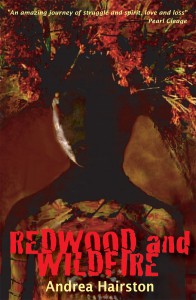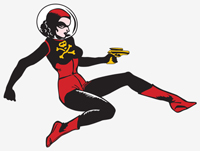Pat Murphy and Karen Joy Fowler, our founding mothers, are planning their trip to Lublin, Poland, to accept the 2011 Thomas D. Clareson Award for Distinguished Service, which is being presented to the Tiptree Motherboard by the Science Fiction Research Association for “outstanding service activities–promotion of SF teaching and study, editing, reviewing, editorial writing, publishing, organizing meetings, mentoring, and leadership in SF/fantasy organizations.” The conference is in early July.
Dubravka Ugresic honored for Tiptree Award
Although Dubravka Ugresic was unable to attend, we honored her in absentia at WisCon 35. The beautiful original art trophy by Johnna Klukas was on display in the WisCon art show. The trophy, the traditional chocolate, and her award certificate will be given to Ugresic in August by our woman in Amsterdam, Julie Phillips (author of James Tiptree, Jr.: The Double Life of Alice Sheldon
2011 Otherwise Award Jury
The 2011 jury is closing recommendations at the end of this month and zeroing in towards winners and an honor list: This year’s jurors are: Lynne Thomas (chair), Karen Meisner, James Nicoll, Tansy Rayner Roberts, and Nisi Shawl. Please recommend anything you read that you think is an interesting exploration and expansion of gender here
Tiptree Book Club Update
The Tiptree Book Club, initially led by Karen Joy Fowler, is going nicely, and we’d love more participants!!! After lively discussions of “Useless Things” by Maureen McHugh, “Galapagos” by Caitlin Kiernan, Lifelode by Jo Walton, and “Beautiful White Bodies” by Alice Sola Kim, Karen Joy Fowler has just started a new thread on Distances by Vandana Singh. The conversation is is here. You might prefer to read the book (a short novel) before you post.
2011 Otherwise Award Winner announced!
Redwood and Wildfire by Andrea Hairston (Aqueduct Press, 2011) is the winner of the 2011 James Tiptree Jr. Award.

Redwood and Wildfire was a favorite of the jurors from the moment they read it. They reported: “This vivid and emotionally satisfying novel encompasses the life of Redwood, a hoodoo woman, as she migrates from rural Georgia to Chicago at the turn of the 20th century. While Redwood’s romance with Aidan Wildfire is central to the novel, female friendship is also a major theme, without deferring to the romance. Hairston incorporates romantic love into a constellation, rather than portraying it as a solo shining star. Her characters invoke a sky where it can shine; they live and love without losing themselves in cultural expectations, prejudices and stereotypes, all within a lovingly sketched historical frame.
“Intersections of race, class, and gender encompass these characters’ entire lives. They struggle with external and internal forces around questions of gender roles, love, identity, and sexuality. This challenge drives how they move through the world and how it sees them. The characters in Redwood and Wildfire deftly negotiate freedom and integrity in a society where it’s difficult to hold true to these things.”
This year’s jurors were Lynne Thomas (chair), Karen Meisner, James Nicoll, Tansy Rayner Roberts, and Nisi Shawl.
Honor List
In addition to selecting the winner, the jury chose a Tiptree Award Honor List. The Honor List is a strong part of the award’s identity and is used by many readers as a recommended reading list for the rest of the year. This year’s Honor List is:
Libba Bray, Beauty Queens (Scholastic Press 2011) — In this atypically comedic Tiptree candidate, a cast of iconic characters trapped on a hostile island (populated by the capitalist analog of Doctor No) illuminates the limited palette of roles for women and offers the hope of more rewarding and rounded lives.
L. Timmel Duchamp, “The Nones of Quintilus” (in her collection Never at Home, Aqueduct Press 2011) — This standout story addresses the relationships between mothers and daughters and how the world looks different when you become (or intend to become) pregnant.
Kameron Hurley, God’s War (Night Shade Books 2011) — Set on a marginally habitable world divided by a common religion with diverse interpretations, this engaging work explores a militaristic matriarchal society.
Gwyneth Jones, The Universe of Things (Aqueduct Press 2011) — Running through these gorgeous stories is a fierce awareness of how gender roles and other social power imbalances are always factors in how we think, how we approach one another, how we see the world. The author questions the status quo, and then questions the questioning, so what emerges is a mature, honest, thoughtful complexity.
Alice Sola Kim, “The Other Graces” (Asimov’s Science Fiction, July 2010) — This elegantly written short story revisits the role of mirroring in self-actualization and casts that path in a new and skiffy light as its heroine, Grace, is mentored by her older alternate selves. It also depicts racial/cultural intersections with gender roles.
Sandra McDonald, “Seven Sexy Cowboy Robots” (Strange Horizons, 2010.10.04) — A surreal and subversive take on human-AI relations. An older female character exploring her sexuality is a rare thing in science fiction, and it is refreshing to see it handled here with such a deft hand.
Maureen F. McHugh, “After the Apocalypse” (in her collection After the Apocalypse, Small Beer Press 2011) — This title story of an impressive collection brings to the foreground gender expectations concerning the practice of motherhood in extreme situations and then completely and matter-of-factly upends them.
Delia Sherman, The Freedom Maze (Big Mouth House 2011) — A clear-hearted, magically immersive time travel story that explores powerful ideas. Thrown back through time to an antebellum plantation, a thirteen-year-old comes to understand how women’s experience is shaped by cultural expectations as they interweave with social, economic, and racial truths.
Kim Westwood, The Courier’s New Bicycle (Harper Voyager Australia 2011) — This compelling novel depicts a variety of sexually transgressive characters and looks at themes of fertility and alternate family structures through a dystopic lens.
The jury also named a “long list” of books worth mentioning, which is available at the link at the top of this page.
Distances by Vandana Singh
Here is what the jury said:
“Singh has packed this novella-length work with an amazing complexity. DISTANCES is: the story of a woman’s development as an artist in a context where science, art and religion are indistinguishable; a meditation on the uses of knowledge and the power structures they engender; and a nuanced depiction of cultural difference, loss and exile. While not as directly focused on gender as some other works on our list, we saw DISTANCES as a work that expanded and challenged a number of inherently gendered cultural categories. Also, almost incidentally, there are some very interesting depictions of alternative sex and gender arrangements.”
There is a lot to talk about in this book, but let’s just start with its Tiptree-ness. Much of the jury discussion around it had to do with whether, a work with gender imbedded in almost every aspect, but never really foregrounded, was what we were looking for.
Book Club Plans
I am at the start of a really busy summer and not sure what my email access will be some of that time. So I’ll be a bit in and out and apologize for that.
I am planning on Vandana Singh’s Distances as our next book and hoping for lots of help from you all. Let’s take a week or so to get it read and then reconvene here to talk about it. And Nancy has volunteered to lead us through NK Jeminson’s The Hundred Thousand Kingdoms in August. Yay!
I’m thinking probably a short story in between the two, and am open to suggestions as to which. What do you all think?
May 29, 2011
20th Anniversary of the Tiptree Award. Ceremony at WisCon 35.
May 2011
Tiptree Month.
Alice Sola Kim, Beautiful White Bodies
Here is the annotation for Kim’s story: A dangerous plague is turning high school girls into ravishing beauties. We found this story’s illumination of teenage girlhood and its passionate desires to be a quite heartbreaking meditation on the meaning of beauty and femininity in the media and popular culture. Especially lovable — the main character. Especially pertinent to us — our protagonist’s hopeless assurances that really, girl geeks can grow up okay. Especially fabulous — the marvelous voice of the piece and the amazing ending.
At least one person on the jury that year believed that feminism is currently located in intersectionality; that it’s no longer possible much less desirable to discuss gender and divorce it from race and class, etc. The primary focus of the Kim story is on a traditional issue of feminism, ie ,physical female beauty. But it also provides a textbook example of intersectionality, particularly with regard to race. I thought we could start there, with the story’s various intersectionalities and then, of course, go wherever you all would like.
The story is available online here: Strange Horizons Fiction: Beautiful White Bodies, by Alice Sola Kim.
